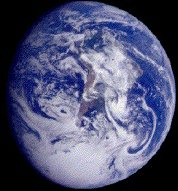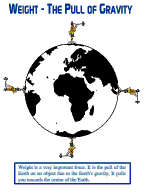
 |
Earth - our home planet |
|
| |
 Vital StatsEarth-Moon Partnership The Earth is accompanied by one natural satellite; the Moon. Occasionally, they pass in front of the sun, casting a shadow onto each other. These are called eclipses. The Earth is accompanied by one natural satellite; the Moon. Occasionally, they pass in front of the sun, casting a shadow onto each other. These are called eclipses.
The image above was taken by the Galileo spacecraft on its way to Jupiter. Both the Earth and Moon appear as crescents. Click to enlarge. Can you work out where the Sun was? Air To BreatheThe atmosphere is composed mainly of nitrogen (78%) and oxygen (21%), with small traces of other gases. These proportions remain fairly constant up to around 80km, but the heavy gases become rare at greater heights and only hydrogen and helium are found in the outermost regions. Fig. 1: The Thin Atmosphere 25km above the surface, a concentrated layer of ozone (O3) exists. This ozone layer is vital to life on the planet, as it stops nearly all of the Sun's harmful ultraviolet radiation from reaching the surface. Scientists believe that we have been damaging it, increasing the risk of skin cancer.
Click for a LIVE satellite image of Europe's weather!
Regions of the Earth towards the poles experience regular light shows in their night skies - the famous auroras caused by the sun. Read more.
|
Cloudless Earth? The image shows the Earth's surface as it would look without clouds. It was made from mosaic of thousands of satellite images. Click to enlarge. The image shows the Earth's surface as it would look without clouds. It was made from mosaic of thousands of satellite images. Click to enlarge.
The Pull of Gravity Until Newton, no-one had any real idea as to why we all walk around on the surface of the Earth, held in place by an invisible force. Newton showed that not only does it hold us in place, but it also holds the planets in orbit around the Sun. Active SurfaceThe surface of the planet has much geological activity, and is shaped by continental drifting (plate tectonics). This makes the surface relatively young. Combined with other factors, such as the atmosphere and weathering, it explains why few visible impact craters can be found. The heavily cratered surface of the moon gives a more accurate guide as to the quantity of collisions with debris making its way through the solar system. Here, surface features date back to the formation of the solar system, and have remained undisturbed due to the moon's geological inactivity.
The structure of the planet itself is divided into three regions: the crust which extends for roughly 7km beneath the oceans and 40km beneath the continents; the mantle which is roughly 2870km thick; and the core which accounts for the remaining 3480km. The core is composed of two layers: the inner is solid; the outer flows. They are both composed mainly of iron, and it is convection in the molten outer layer that plays an important role in accounting for the planet's magnetic field. Interestingly, the magnetic field reverses every million years or so; north becoming south, and vice versa. | ||||||||||
|
Sun | Mercury | Venus | Earth | Moon | Mars | Asteroids | Jupiter | Saturn | Uranus | Neptune | Pluto | X | Kuiper | |||||||||||